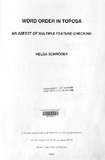| dc.description.abstract | The purpose of this thesis Is to provide a feature-checking approach to sentence structure and language typology within the generative framework, based on Toposa, a highly inflectional Eastern Nilotic language of Sudan.
It was common belief among generativists that in Universal Grammar (UG) the sentence is derived through a grammatical subject and its position in the inflectional phrase (IP) and the verb phrase (VP) that has a c-commanded object. This thesis suggests that factors beyond sentence level play an important role in the conceptualisation of sentences. The thesis claims that sentence structure is determined by a multiple feature-checking process, and that the computational process is driven by the interaction between morphology, syntax and discourse functions, such as antecedent relationship and focus. Until recently it was not common to make discourse considerations part of the process for forming sentence structure. However the findings of Li & Thompson (1976) have demonstrated that there are languages where the formation of sentences is not only motivated by structural constituents of grammatical subject and object, but also by discourse functions such as topic. Kiss (1995) followed up the thinking of Li & Thompson and showed that there are indeed languages where the discourse functions of topic and focus determine the sentence structure. While Kiss still saw the discourse functions of topic and focus as isolated syntactic features, this thesis proposes to go a step further and to view morphology, syntax and discourse functions as merged in a multiple feature-checking process that is responsible for sentence structure and word order.
The feature-motivated interrelation of morphology, syntax, and discourse explain the occurrence and absence of the grammatical subject, the object and verbal constituents in discourse and leads to an ergative VS/VO word order in Toposa, where the preferred argument structure is to have only one argument after the verb. This contrasts with older analyses of a VSO word order for Toposa (Dimmendaal, 1983b: 130. Creider 1989: 35, Givon 1976: 73-74). The complex relationship between morphology, syntax and discourse is demonstrated through the morphology of the passive, the reflexive, the subject prefixes in the verb, the causative and the applicative in Isolation, in complex combinations and in discourse.
Although the thesis presents data from Toposa, it wants to contribute to aspects of general linguistic theory. For this purpose, the Minimalist Program (Chomsky 1993/1995) has been used as framework.
Chapter one describes the background to the study, some basic language features, it states the problem and the objectives of the study, outlines hypotheses, the rationale, the scope and limitation, provides a literature review, and discusses the research methodology and the significance of the study.
Chapter two discusses the theoretical framework of the Minimalist Program. It distinguishes between the nominative-accusative and the ergative-absolutive parameter, it discusses the pro-drop parameter, the discourse configurationality of topic and focus, basic constituent order and the notion of subject.
Chapter three presents the basic morpho-syntactic representations of Toposa. i.e. its verbal morphology, simple sentence structure, the morphological case-marking system, and some traces of morphological ergativity.
Chapter four shows complex verbal morphology and its relevance for sentence formation and word order questions.
Chapter five discusses the significance of the verbal morphology in discourse. It describes how the Principle of Reference captures the relationship between an antecedent and the subsequent occurrences of verbal affixes and how the Principle of Focus in relationship to verbal morphology manifests the word order.
Chapter six shows how the interrelation of focus, syntax and morphology leads to an ergative VS /VO word order.
Chapter seven summarises the findings of the thesis and discusses the theoretical implications for linguistic theory. | |

